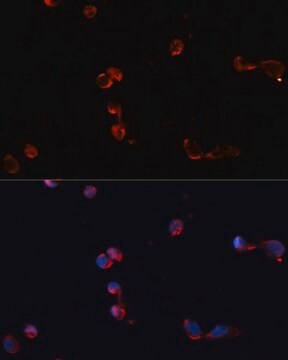推薦產品
生物源
rabbit
共軛
unconjugated
抗體表格
IgG fraction of antiserum
抗體產品種類
primary antibodies
無性繁殖
polyclonal
形狀
buffered aqueous solution
分子量
antigen 26 kDa
加強驗證
recombinant expression
Learn more about Antibody Enhanced Validation
技術
indirect immunofluorescence: 10 μg/mL using eukaryotic cells transfected with a plasmid bearing the CAT gene
western blot: 10 μg/mL using eukaryotic cells transfected with a plasmid bearing the CAT gene
運輸包裝
dry ice
儲存溫度
−20°C
目標翻譯後修改
unmodified
一般說明
Chloramphenicol Acetyl Transferases (CATs) shows conservation and differences in their amino acid sequences. CAT is encode by cat gene and exists as monomer and later assemble into a trimer.
特異性
Anti-Chloramphenicol Acetyl Transferase (CAT) antibody is specific for bacterial CAT and recombinant CAT expressed in transfected eukaryotic cells (a predominant band of approx. 26 kD).
免疫原
bacterial chloramphenicol acetyl transferase (CAT).
應用
Anti-Chloramphenicol Acetyl Transferase (CAT) has been used in
- immunoblotting
- indirect immunofluorescence
- immunofluorescence microscopy
生化/生理作用
Bacterial chloramphenicol acetyl transferase (CAT) is an enzyme that catalyzes the inactivation of the antibiotic, chloramphenicol, by acetylation and subsequently confers bacterial resistance to the antibiotic. CAT, being a stable prokaryotic enzyme, is often used as a reporter gene in transfection assays developed for eukaryotic promoters. Quantification of reporter gene expressions, such as that of CAT, can be correlated to the transcriptional functions of the target sequence. Thus, antibodies directed against CAT can be used for the study of gene sequences that are fused to the CAT reporter gene
Anti-Chloramphenicol Acetyl Transferase (CAT) antibody is specific for bacterial CAT and recombinant CAT expressed in transfected eukaryotic cells (a predominant band of approx. 26 kD). Staining of CAT by the antibody is inhibited by the bacterial CAT antigen in cells transfected with CAT.
Anti-Chloramphenicol Acetyl Transferase (CAT) antibody is specific for bacterial CAT and recombinant CAT expressed in transfected eukaryotic cells (a predominant band of approx. 26 kD). Staining of CAT by the antibody is inhibited by the bacterial CAT antigen in cells transfected with CAT.
外觀
0.01M 磷酸缓冲盐溶液,pH 7.4,含 15mM 叠氮化钠。
免責聲明
Unless otherwise stated in our catalog or other company documentation accompanying the product(s), our products are intended for research use only and are not to be used for any other purpose, which includes but is not limited to, unauthorized commercial uses, in vitro diagnostic uses, ex vivo or in vivo therapeutic uses or any type of consumption or application to humans or animals.
未找到適合的產品?
試用我們的產品選擇工具.
儲存類別代碼
10 - Combustible liquids
水污染物質分類(WGK)
WGK 3
閃點(°F)
Not applicable
閃點(°C)
Not applicable
從最近期的版本中選擇一個:
分析證明 (COA)
Lot/Batch Number
Eva Bjur et al.
Infection and immunity, 74(9), 5140-5151 (2006-08-24)
The effect of the cytoplasmic reductase and protein chaperone thioredoxin 1 on the virulence of Salmonella enterica serovar Typhimurium was evaluated by deleting the trxA, trxB, or trxC gene of the cellular thioredoxin system, the grxA or gshA gene of
W V Shaw
CRC critical reviews in biochemistry, 14(1), 1-46 (1983-01-01)
Naturally occurring chloramphenicol resistance in bacteria is normally due to the presence of the antibiotic inactivating enzyme chloramphenicol acetyltransferase (CAT) which catalyzes the acetyl-S-CoA-dependent acetylation of chloramphenicol at the 3-hydroxyl group. The product 3-acetoxy chloramphenicol does not bind to bacterial
Chloramphenicol acetyltransferase assay.
Smale, S., T.
Cold Spring Harbor Protocols, doi:10-doi:10 (2010)
Ralph L McWhinnie et al.
Applied and environmental microbiology, 80(1), 226-234 (2013-10-22)
In this work, we describe the identification of synthetic, controllable promoters that function in the bacterial pathogen Francisella novicida, a model facultative intracellular pathogen. Synthetic DNA fragments consisting of the tetracycline operator (tetO) flanked by a random nucleotide sequence were
Bhaskar Anand Jha et al.
FEBS letters, 589(15), 1966-1974 (2015-06-02)
DRBD13 RNA-binding protein (RBP) regulates the abundance of AU-rich element (ARE)-containing transcripts in trypanosomes. Here we show that DRBD13 regulates RBP6, the developmentally critical protein in trypanosomatids. We also show DRBD13-specific regulation of transcripts encoding cell surface coat proteins including
Active Filters
我們的科學家團隊在所有研究領域都有豐富的經驗,包括生命科學、材料科學、化學合成、色譜、分析等.
聯絡技術服務





